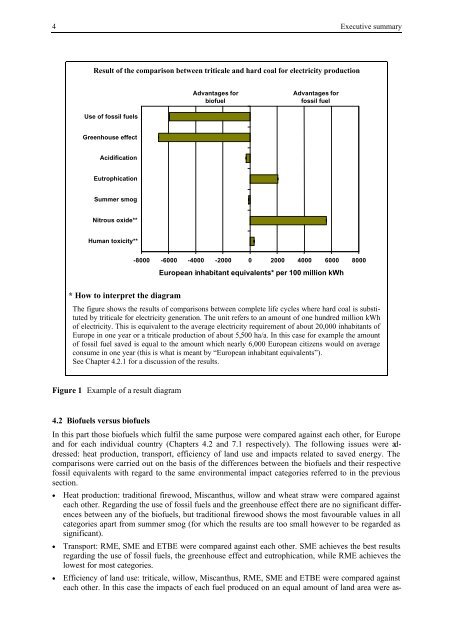BIOENERGY FOR EUROPE: WHICH ONES FIT BEST?
BIOENERGY FOR EUROPE: WHICH ONES FIT BEST?
BIOENERGY FOR EUROPE: WHICH ONES FIT BEST?
You also want an ePaper? Increase the reach of your titles
YUMPU automatically turns print PDFs into web optimized ePapers that Google loves.
4 Executive summary<br />
Result of the comparison between triticale and hard coal for electricity production<br />
Use of fossil fuels<br />
Greenhouse effect<br />
Acidification<br />
Eutrophication<br />
Summer smog<br />
Nitrous oxide**<br />
Human toxicity**<br />
* How to interpret the diagram<br />
Advantages for<br />
biofuel<br />
Advantages for<br />
fossil fuel<br />
-8000 -6000 -4000 -2000 0 2000 4000 6000 8000<br />
European inhabitant equivalents* per 100 million kWh<br />
The figure shows the results of comparisons between complete life cycles where hard coal is substituted<br />
by triticale for electricity generation. The unit refers to an amount of one hundred million kWh<br />
of electricity. This is equivalent to the average electricity requirement of about 20,000 inhabitants of<br />
Europe in one year or a triticale production of about 5,500 ha/a. In this case for example the amount<br />
of fossil fuel saved is equal to the amount which nearly 6,000 European citizens would on average<br />
consume in one year (this is what is meant by “European inhabitant equivalents”).<br />
See Chapter 4.2.1 for a discussion of the results.<br />
Figure 1 Example of a result diagram<br />
4.2 Biofuels versus biofuels<br />
In this part those biofuels which fulfil the same purpose were compared against each other, for Europe<br />
and for each individual country (Chapters 4.2 and 7.1 respectively). The following issues were addressed:<br />
heat production, transport, efficiency of land use and impacts related to saved energy. The<br />
comparisons were carried out on the basis of the differences between the biofuels and their respective<br />
fossil equivalents with regard to the same environmental impact categories referred to in the previous<br />
section.<br />
• Heat production: traditional firewood, Miscanthus, willow and wheat straw were compared against<br />
each other. Regarding the use of fossil fuels and the greenhouse effect there are no significant differences<br />
between any of the biofuels, but traditional firewood shows the most favourable values in all<br />
categories apart from summer smog (for which the results are too small however to be regarded as<br />
significant).<br />
• Transport: RME, SME and ETBE were compared against each other. SME achieves the best results<br />
regarding the use of fossil fuels, the greenhouse effect and eutrophication, while RME achieves the<br />
lowest for most categories.<br />
• Efficiency of land use: triticale, willow, Miscanthus, RME, SME and ETBE were compared against<br />
each other. In this case the impacts of each fuel produced on an equal amount of land area were as-

















